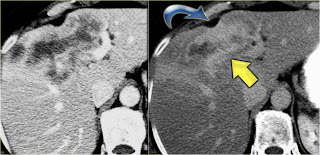 dilated proximal right ureter.
dilated proximal right ureter. at 1 cm caudal,right uerter passes behind IVC(arrow).
at 1 cm caudal,right uerter passes behind IVC(arrow). at 1 cm caudal,right ureter lies anterior to IVC,compare it
at 1 cm caudal,right ureter lies anterior to IVC,compare itwith left ureter which lie infront of left psoas muscle.
With CT, the proximal right ureter can be seen coursing medially behind and then anteriorly around the IVC so as to encircle it partially .
Reference:BiblioMed Textbook-Computed Body Tomography

















































